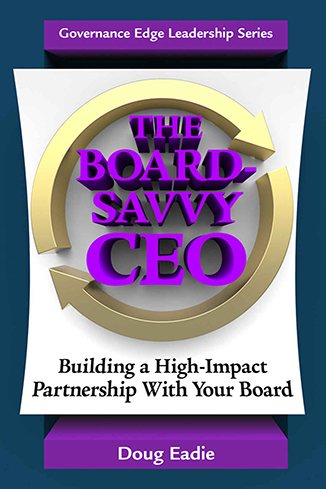A few years ago, I was chatting over lunch with the CEO of a national association about her incoming board chair. She was feeling pretty apprehensive since her relationship with the outgoing chair had been really rocky. He’d resisted her overtures to work together as a leadership team, in fact, he’d behaved more like a competitor than partner on several occasions during his term. For example, he’d aggressively challenged her in a recent board budget work session about a couple of key revenue assumptions she’d presented. And this was after she’d tried – and failed – to get him to spend an hour or so on the phone going over the assumptions a week before the work session.
“I feel so worn down,” I recall her saying, “that I can’t face a second straight year jousting with my chair.” She said she’d appreciate any thoughts I wanted to share about turning her new chair into a real partner. She made clear she didn’t need a friend chairing the board, but she’d love not having an adversary in the role. I told her I definitely had some thoughts to share, and we scheduled three coaching sessions over the coming five weeks to come up with some practical ways to build a solid relationship with her new chair.
During our first one-on-one session, the CEO and I discussed what I told her was the indispensable first step in partnership building: getting to know her new chair in depth – really, really well. I told her that distance is a cardinal sin in the relationship building business, so she’d be well advised to spend a big dollop of one-on-one quality time with her new chair from the get-go – preferably in person. Otherwise, she wouldn’t know enough to move to the next step in building this really critical new relationship. We went over a number of things she needed to know, such as the impact her chair aspired to have – his imprint, so to speak, his passionate professional interests, how he preferred to communicate with her on an ongoing basis, etc.
Once we’d covered what she needed to know about her incoming chair, she asked about the next step in the process. My response? “Now you put together your chair’s compensation package.” By the expression on her face, I could tell she was thinking to herself, “What’s Doug smoking? He’s got to know our board chair’s an unpaid volunteer who at most’ll get reimbursed for some travel expenses.” I assured her I was well aware that her chair couldn’t earn a real paycheck for his work in the board room, but had she ever thought about non-monetary compensation for her chair? She couldn’t assume that altruism alone would take her chair very far on the partnership road. Over the years, I’d learned that the typical board chair expects a more robust return on her investment of time and energy than just the satisfaction that comes from doing a great job in the boardroom. At the end of this first coaching session, the CEO and I agreed that after she’d spent enough time getting to know her new chair in depth, our second and third coaching sessions would focus on brainstorming the elements of a non-monetary compensation package for the chair.
Lett me tell you about three of the initiatives this CEO and I came up with – in terms of the non-monetary compensation her chair would earn – based on what she’d learned about the chair:
- First, her chair was passionately interested in the association’s international growth, so the CEO would help him put together a task force charged to come up with a comprehensive, first-phase strategy to expand in North and South America and Western Europe. The chair would serve as an ex officio member, and the CEO would provide the staff support required for the task force to succeed.
- Second, one of the new chair’s professional goals was to play a leading role in taking the board’s leadership to the next level during his term, so the CEO would design a daylong board governance retreat aimed at identifying governance issues and brainstorming possible solutions in the form of board improvement targets. The CEO would involve her chair in selecting the facilitator, would support the chair in playing a leading role in the retreat, and would make sure that there was strong staff support in following-through: mainly refining and implementing the governance improvement targets that’d come out of the retreat..
- And third, in response to the chair’s obvious desire for public recognition, the CEO would ensure that he was given a primo speaking spot at the next annual meeting and the budget to travel to regional chapter meetings.
These are just a few of the items making up the non-monetary compensation package we came up with during our coaching sessions. What you need to know is that the package really worked. It helped create a close and positive and productive board chair-CEO partnership with none of the friction the CEO had experienced with her prior chair. Please comment and share how you’ve “paid” your board chair.






